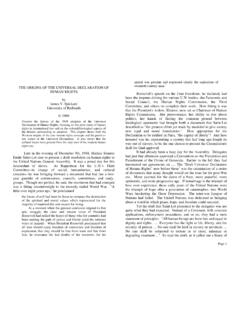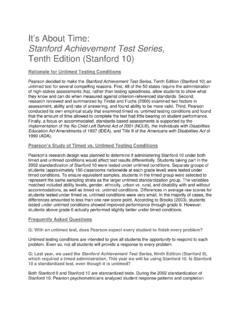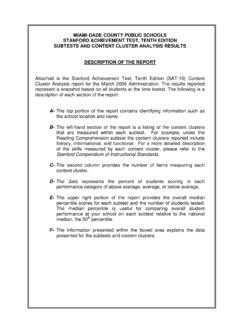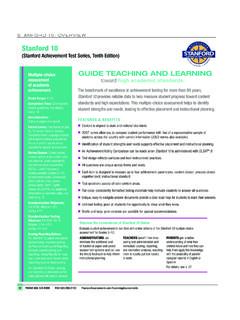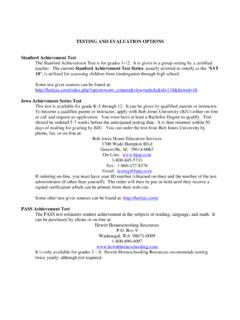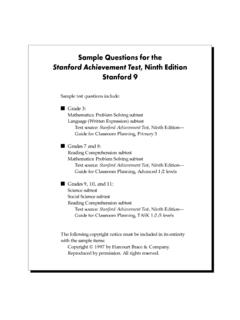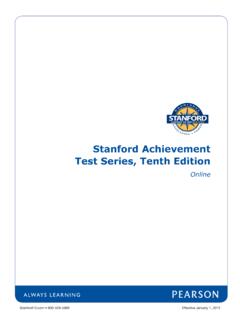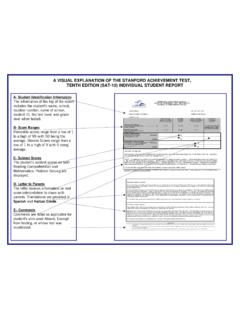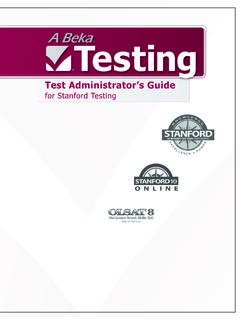Transcription of 2 Academic Achievement of Deaf Students
1 2 Academic AchievementRoss E. Mitchellof Deaf StudentsThe National Research Council (2001) identifies the practice of educational assess-ment as that which seeks to determine how well Students are learning and is anintegral part of the quest for improved education. It provides feedback to stu-dents, educators, parents, policymakers, and the public about the effectiveness ofeducational services (p. 1). Especially relevant to assessing the Academic achieve-ment of deaf Students , this perspective assumes that the scores attained on stan-dardized tests of Academic Achievement are valid and reliable indicators of whatthese Students have learned; that the assessment results allow Students as well astheir families, teachers, and other interested parties to recognize their strengthsand weaknesses.
2 And that by identifying these strengths and weaknesses, familiesand schools have information that assists in designing and implementing pro-grams and services that may improve the Academic performance of these latest reauthorizations of the two major federal education laws, namely, theNo Child Left Behind Act of 2001 (hereafter NCLB) and the Individuals WithDisabilities Education Improvement Act of 2004 (hereafter IDEA 2004), substan-tially incorporate the National Research Council s views on is,in addition to mandating a regime for school-based accountability that dependson the results of student test performance.
3 Current federal law encourages high-quality assessment practices that would provide detailed information about stu-dent Academic performance and would be valuable for planning instruction andeducational Achievement RECORDTwo recent national studies provide important updates on the performance ofdeaf Students on standardized assessments of Academic Achievement . The Gal-laudet Research Institute established national norms for deaf and hard of hearingstudent performance on the stanford Achievement Test series , 10th edition (theNational Deaf and Hard of Hearing Student Norms Project is described in Gal-laudet Research Institute, 2004; Mitchell, Qi, & Traxler, 2008, in press), the fifthsuch study undertaken by the Gallaudet Research Institute over the last four de-cades (see also, , Allen, 1986; Holt, Traxler, & Allen, 1992, 1997; Office of1.)
4 For example, NCLB ; NCLB , iii, xii, xv; and IDEA 2004 Studies, 1969; Traxler, 2000). At about the same time, SRI Interna-tional conducted a similar study of deaf Students Academic Achievement as partof a comprehensive evaluation of the Individuals With Disabilities Education ActAmendments of 1997 (hereafter IDEA 1997) overseen by the Office of SpecialEducation Programs (OSEP) within the Department of Education ( , seeBlackorby et al., 2005; Wagner et al., 2003; Wagner, Newman, Cameto, & Levine,2006; focusing solely on Students with hearing impairment, see Blackorby & Kno-key, 2006).
5 These two studies are not identical in design, nor do they reportachievement results from the same assessment instrument, but they are comple-mentary. Together, the results of these studies highlight serious concerns aboutthe Academic Achievement levels of deaf presenting mathematics and reading Achievement profiles for deaf stu-dents from the Gallaudet Research Institute and OSEP studies, two critical designdifferences need to be highlighted. First, the OSEP study did not specifically sam-ple schools that enrolled Students with hearing impairments (the applicable IDEA classification) whereas the Gallaudet Research Institute study used for its samplingframe a limited registry of schools and programs known to be serving deaf stu-dents.
6 The consequence of this difference is that the Gallaudet Research Institutestudy is likely to overrepresent (a) deaf Students with more severe hearing lossand (b) deaf Students who attend schools for the deaf and other special programsthat have relatively large numbers of deaf Students (for a description of biases inthe Gallaudet Research Institute study sampling frame, see Mitchell, 2004). An-other way to look at this difference is that the OSEP study is likely to have agreater proportion of Students who are hard of hearing compared with the Gal-laudet Research Institute study.
7 These prevalence differences between the twostudies in severity of hearing loss and instructional program setting placementmean that Achievement levels are expected to be higher for the OSEP study partic-ipants than for those in the Gallaudet Research Institute study (for a discussionof the relationship between Achievement and deaf Students characteristics, seeKarchmer & Mitchell, 2003).Second, the OSEP study is longitudinal in its design whereas the Gallaudet Re-search Institute study is cross-sectional. As a result, except for replacements re-cruited because of attrition, the OSEP study is focused on a specific cohort ofstudents identified for special education in 2000 regardless of their current eligi-bility for special education whereas the Gallaudet Research Institute study per-tains to Students tested in 2003, including Students who were not identified untilafter 2000, had not entered the country until after 2000, or possibly had notbecome deaf until after 2000, but not including Students who had exited specialeducation before 2003.
8 Moreover, the data from the OSEP study analyzed hereare those collected during the second wave of data collection, which was closestin time to the Gallaudet Research Institute data collection activity. Because ofstudy attrition and the difficulty of recruiting replacements, the Achievement lev-els measured in the OSEP study are likely to be higher because, on average, morehigh-performing Students remain in longitudinal studies. The cross-sectional Gal-laudet Research Institute study is more likely to capture low-performing and mo- Academic Achievement of Deaf Students39bile Students .
9 Despite these two important study design differences, certainly,there is significant overlap between the two study populations and, possibly, evenidentical participants. Nonetheless, there is no reason to expect the results ofthese studies to be important difference to highlight before presenting data summariesfrom the OSEP and Gallaudet Research Institute studies is that of the assessmentinstruments. The OSEP study used the Woodcock-Johnson III, which providesage-based norms. That is, the performance distribution is referenced to the ageof the child taking the test batteries, not the child s grade in school.
10 However, theGallaudet Research Institute study used the stanford Achievement Test series ,which provides grade-based norms. One has to assume an age-grade correlationto work with grade-based norms. In other words, Grade 2 norms are used for 8-year-olds, Grade 3 for 9-year-olds, Grade 4 for 10-year-olds, etc. With this verystrong correlation, age-grade-based norms can then be used to compare the twogroups of Students on the two tests . The metric being used is the percentile rankcollapsed into quartiles ( , 1st quartile is 1st 25th percentile, 2nd quartile is26th 50th percentile, 2nd quartile is 51st 75th percentile, and 4th quartile is76th 99th percentile).
